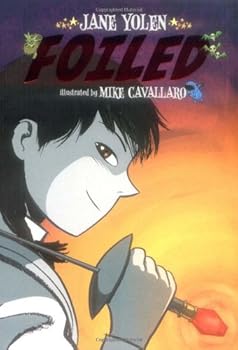
![]() Foiled by Jane Yolen (writer) and Mike Cavallaro (illustrator)
Foiled by Jane Yolen (writer) and Mike Cavallaro (illustrator)
The past few weeks I’ve been spending time writing reviews that focus on new Monthly Comics I think would make good entry points for new comic book readers who have never had pull lists, and I have several more new comics I want to promote. The end of 2013 is an excellent time to be a new reader of comics. However, I must break this series on Monthly Comics because I just read a graphic novel too good for me not to immediately write a review of it: Foiled, written by Jane Yolen and illustrated by Mike Cavallaro. Foiled is clearly a five-star book, and I want to say in the first paragraph in case anybody stops reading here: Buy this book and it’s sequel — Curses! Foiled Again — right now!
Foiled is a coming-of-age fantasy novel about Aliera Carstairs, a high school student who is also an expert at fencing. It starts with a focus on the everyday high school elements, and as we might expect, Aliera doesn’t fit in with the “jocks and jockettes”; “the goths” because as she tells us, ” I don’t look good in black”; “the nerds”; or “the preps.” She’s normal but thankfully not angst-ridden: “I’m fine alone,” she tells us as she leans back against a wall of lockers, looking straight at the reader.
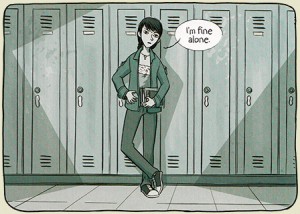 This emotionally strong young woman seems to have her confidence shaken only when a new, overly-cute boy arrives at school, but she holds her own as she spars with him verbally when they are paired as lab partners. This love interest is well-done, with witty dialogue that is not cheesy (and I have a low tolerance for Velveeta), and Cavallaro helps us enjoy their exchanges even more through his depiction of their facial expressions: The full range of emotions seems to play out between these two as they figure out whether they are friends or enemies.
This emotionally strong young woman seems to have her confidence shaken only when a new, overly-cute boy arrives at school, but she holds her own as she spars with him verbally when they are paired as lab partners. This love interest is well-done, with witty dialogue that is not cheesy (and I have a low tolerance for Velveeta), and Cavallaro helps us enjoy their exchanges even more through his depiction of their facial expressions: The full range of emotions seems to play out between these two as they figure out whether they are friends or enemies.
Outside of school, Aliera seems not to connect or spend much time with her parents. The bulk of her time is spent at fencing school, and she is a champion competitor, using for practice the cheap foil her mother picked up bargain shopping. She is so good that she beats everybody her age and most kids above her age, and her going to the Nationals competition seems almost a guarantee. She spends so much time practicing at the fencing school that her main father-figure in the book is her fencing coach.
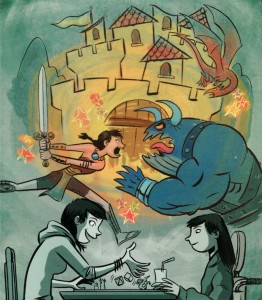 Another of her favorite activities is spending time with her cousin Caroline every Saturday. Caroline has rheumatoid arthritis and is largely wheelchair-bound. Aliera says succinctly in describing the two of them, “I may fence, but she’s always been the brave one.” This line is one of my favorite sentences in the book because it generates such a quick emotional spark. The brevity of the comment and that it is said in passing are what make it such effective pathos. Not surprisingly, much of their time together is spent engaging in imaginative role-playing games in which Caroline is the Queen and Aliera is the captain of her guard. Other than this one sentence, the emotion of their relationship and their play is silently conveyed through Cavallaro’s wonderful art that is marked by the use of shadows (but without darkness) and a large variety of perspectives and angles.
Another of her favorite activities is spending time with her cousin Caroline every Saturday. Caroline has rheumatoid arthritis and is largely wheelchair-bound. Aliera says succinctly in describing the two of them, “I may fence, but she’s always been the brave one.” This line is one of my favorite sentences in the book because it generates such a quick emotional spark. The brevity of the comment and that it is said in passing are what make it such effective pathos. Not surprisingly, much of their time together is spent engaging in imaginative role-playing games in which Caroline is the Queen and Aliera is the captain of her guard. Other than this one sentence, the emotion of their relationship and their play is silently conveyed through Cavallaro’s wonderful art that is marked by the use of shadows (but without darkness) and a large variety of perspectives and angles.
And now I’ve reached the paragraph I’ve been dreading: How do I tell you about the fantasy elements in this book without giving away the plot? First, the obvious is true: Aliera is going to do a little magic, fantastical footwork with weapon in hand. But almost everything else is a surprise. All the reader’s expectations are anticipated and frustrated in the best possible ways! As the slide into the fantasy world begins, people are not who you think they would be even though you know they will not be who they first appear. In other words, Yolen anticipates 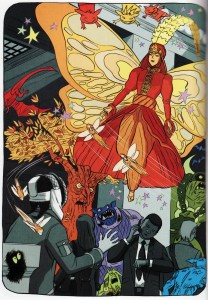 that many of us have read stories like this one, and she changes things up a bit for us. It’s quite refreshing. Let me just say that the right fantasy elements are there: You’ll get trolls and fairies, villains and heroes, and, if you stick around for volume two, you’ll even get to spend time with Baba Yaga — and she doesn’t have merely a minor role.
that many of us have read stories like this one, and she changes things up a bit for us. It’s quite refreshing. Let me just say that the right fantasy elements are there: You’ll get trolls and fairies, villains and heroes, and, if you stick around for volume two, you’ll even get to spend time with Baba Yaga — and she doesn’t have merely a minor role.
But my favorite aspect of this top-notch graphic novel? The artwork. Mike Cavallaro has managed to create a little masterpiece here. The thought and detail that went into this book is amazing. As an accomplished visual storyteller, Cavallaro achieves an impressive feat that is easy to miss because it is supposed to be invisible: He makes the story flow. Never do I feel lost, wondering what panel to go to and where to look to read the next bit of dialogue. I’ve always appreciated this aspect of visual storytelling when it is done well.
However, I rarely mention visual flow unless I believe it’s a problem. I mention it in this review because creating flow is only an easy one to accomplish IF a simple, regular pattern of panels is used. The smooth reading flow Cavallaro creates for his readers is particularly impressive to me because the artist is so creative in his variations from page-to-page. He uses about every type of angle and panel that is possible: He stretches panels across pages and he uses splash pages; he uses regular vertical panels and regular horizontal panels; he combines the two kinds and he overlaps the two kinds. You name it; it’s there.
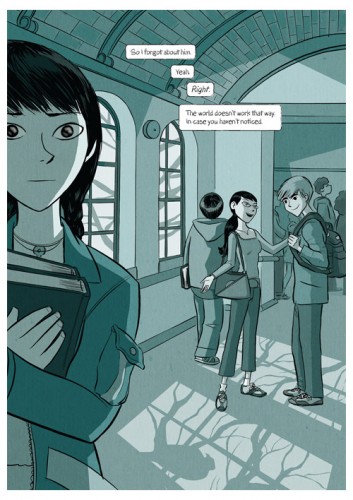 But good flow and variation — though I appreciate them — do not lead me to rave about the art in a comic. Here are the qualities of his art in this book I like the best: The facial expressions. They aren’t too detailed, but they are very effective. There’s a very slight manga influence seen in those expressions, mainly when a character is feeling an extreme emotion, but overall, the dynamics between the characters are often best seen in the close-up shots on their faces.
But good flow and variation — though I appreciate them — do not lead me to rave about the art in a comic. Here are the qualities of his art in this book I like the best: The facial expressions. They aren’t too detailed, but they are very effective. There’s a very slight manga influence seen in those expressions, mainly when a character is feeling an extreme emotion, but overall, the dynamics between the characters are often best seen in the close-up shots on their faces.
Another feature of the art I love is Cavallaro’s use of shadows. I don’t remember ever mentioning the use of shadows in one of my reviews, either, but Cavallaro’s use of shadows is a major component of this story. A high percentage of the pages have these shadows, but since they are done in greys rather than in black, the result is a book full of light. The book has no bright colors until later in the book, so these shadows are the real attraction, particularly since there’s always a bird on those branches whose shadows seem to make their way across every panel. I wonder what that’s all about? Hmm . . . .
Just as the shadows and bird are tied into certain elements of the story I can’t really talk about without spoiling your fun, so too is my final favorite aspect of the artwork: The color. The comic doesn’t introduce color until we get far into the story — and I can’t tell you why — but when it does, it’s absolutely fantastic! It’s not merely because the reader’s eyes are now longing for some color, and it’s not merely that the color provides a contrast to what has come before: It’s that the color does not take over the comic. It remains partial, a splash here and a splash there. And Cavallaro’s use of colors is stunning. For example, there’s one beautiful little panel with a jewel — one red ruby — in it, and reflected back to us is a ruby-red-tinged, upside-down image of Aliera frowning back at herself, even though we can’t see her actual real face in the panel. This little panel is a perfect example of the type of minute detail that Cavallaro includes throughout the comic.
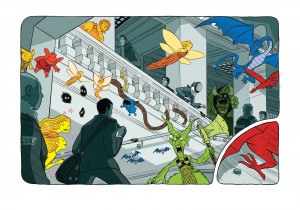 I rarely talk at length about the artwork in a comic because I feel — I know — I lack expertise, the specialized vocabulary, to explain accurately, fully, and with justice the visual components of a graphic novel. My training is in the study of poetry and prose. I’ve made the attempt to about art here because to not do so would be to skip over my favorite part of this particular book. I will do my best to include artwork with this review that does justice to Cavallaro’s work here, but with all honesty, I think the full effect can be felt only by flipping through the actual book.
I rarely talk at length about the artwork in a comic because I feel — I know — I lack expertise, the specialized vocabulary, to explain accurately, fully, and with justice the visual components of a graphic novel. My training is in the study of poetry and prose. I’ve made the attempt to about art here because to not do so would be to skip over my favorite part of this particular book. I will do my best to include artwork with this review that does justice to Cavallaro’s work here, but with all honesty, I think the full effect can be felt only by flipping through the actual book.
One final note: The book is aimed at young adult and teen readers, perhaps because a few references are made that might be considered “mature.” My eleven-year-old did not seem to mind or ask me questions about them, and my eight-year-old didn’t even notice them because the pictures didn’t call attention to what are solely textual allusions. Without maybe two words, the book would be great to read to an eight-year-old even (just skip over the words while you read). But if you are a teen, the book is absolutely fine. And if you’re an adult? There’s nothing to stop you from reading this refreshing fantasy novel and its sequel. It has an instant classic feel to it — much like Jeff Smith’s BONE. My only fear is that they won’t come out with a third book.



I’m taking your advice and ordering. The Amazon link didn’t work for me. Got a ‘this isn’t a functional link on our site’ message.
Fixed. Thanks for heads up, Sarah!